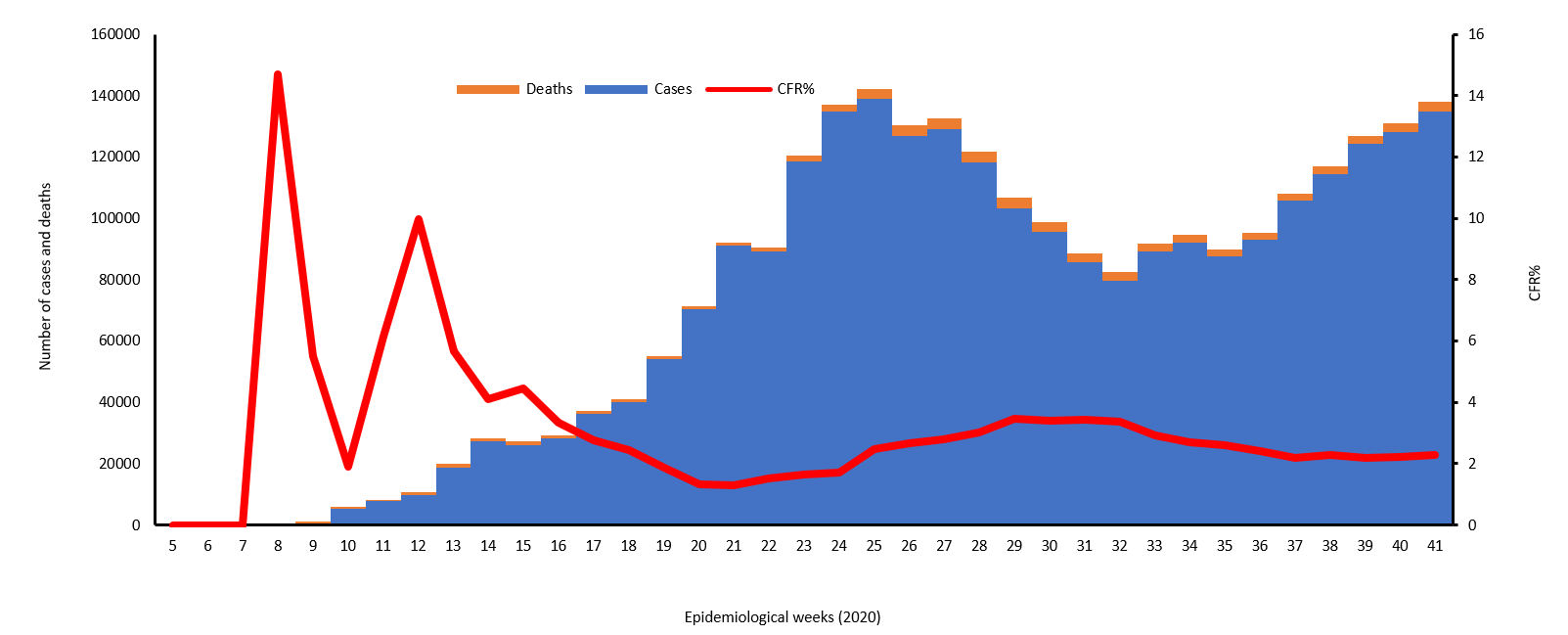12 October 2020 – The coronavirus disease COVID-19 continues to spread at the regional and global levels. As of 10 October 2020, the global cumulative incidence reached 36 762 337 reported cases and 1 064 858 associated deaths with a case fatality ratio (CFR) of 2.9%. Meanwhile, the 22 countries of the Eastern Mediterranean Region (EMR) have reported a total of 2 604 716 cases, which represent about 7.1% of the global count, with 66 313 associated deaths (CFR 2.6%). Most countries in the Region are in the community transmission phase.
Since the beginning of the outbreak, the country that has reported the highest number of total cases in the Region is Islamic Republic of Iran (496 253 cases; 19.1% of the Region’s total), followed by Iraq (400 124; 15.4%) and Saudi Arabia (338 944; 13%). Islamic Republic of Iran also reported the highest number of total associated deaths (28 293; CFR 5.7%) followed by Iraq (9790; CFR 2.4%) and Pakistan (6558; CFR 2.1%). The highest CFRs were reported by Yemen (29%) followed by Sudan (6.1%), while the lowest CFRs were reported by Qatar (0.2%) followed by Bahrain (0.4%).
During epidemiological week 41, the Region reported a 5.3% increase in cases when compared to the previous week (134 908 cases compared to 128 117 cases). Similarly, a 9% increase was observed for associated deaths (3098 deaths compared to 2842 deaths). The weekly trend per capita showed a slight increase as compared to the previous week (356/100 000 compared to 337/100 000).
Jordan, Tunisia and Lebanon reported a relative increase in COVID-19 activity. The cumulative number of cases in Jordan increased from 14 749 to 23 998 (63% increase compared to the previous weeks), Tunisia from 23 453 to 31 259 (33% increase) and Lebanon from 43 480 to 52 558 (21% increase). Jordan had the largest relative increase in deaths (106%) followed by Tunisia (42%) and Lebanon (14%).
In terms of testing, a total of 39 217 280 laboratory PCR tests were conducted since the start of the outbreak across the Region including 2 237 876 tests in week 41, which shows a 2% increase compared to the previous week (2 186 614). The highest number of PCR tests were reported from United Arab Emirates (10 million), followed by Saudi Arabia (6.9 million) and Islamic Republic of Iran (4.2 million). The United Arab Emirates and Bahrain are performing the highest rate of testing per capita (109 269/100 000 and 90 441/100 000, respectively). The average positivity rate for the Region is 6.6%. WHO recommends a positivity rate of around 3–12% as a general benchmark indicating adequate testing, which was achieved in most countries of the Region.
Supporting countries in the Region
The regional incident management support team continues to coordinate the response and provide technical support to countries and partners in the Region in the areas of coordination and partnership, surveillance, laboratory capacity, clinical management, infection prevention and control, risk communication, points of entry according to the International Health Regulations (2005), research, health system, essential health services among others. Activities this week included:
providing technical support to Member States on the use of antigen-detection rapid tests in the diagnosis of COVID-19;
conducting the first virtual meeting on infection prevention and control (IPC) of reproductive, maternal, neonatal, child and adolescence health services in the context of COVID-19 pandemic in the Region with participation of 85 participants from 14 countries;
convening the 6th regional taskforce on COVID-19 and migration with IOM, ILO and ESCWA;
launching online workshop on COVID-19 clinical management in Jordan to train frontline clinicians and nurses managing COVID-19 cases in designated hospitals. The workshop will be conducted from 5 to 26 October 2020 and will include a series of 7 virtual sessions over a 1-month period;
launching of COVID-19 national Rapid Response Teams global virtual learning series where the first webinar was focused on contact tracing and active case finding in context of COVID and was attended by over 250 rapid response team members from across the Region.

For more data from the Region, please visit the COVID-19 dashboard.
Subscribe to the monthly infectious hazard preparedness newsletter of WHO’s Health Emergencies Programme for latest data and analysis on epidemic- and pandemic-prone diseases, as well as news on outbreak preparedness and response within WHO’s Eastern Mediterranean Region.




